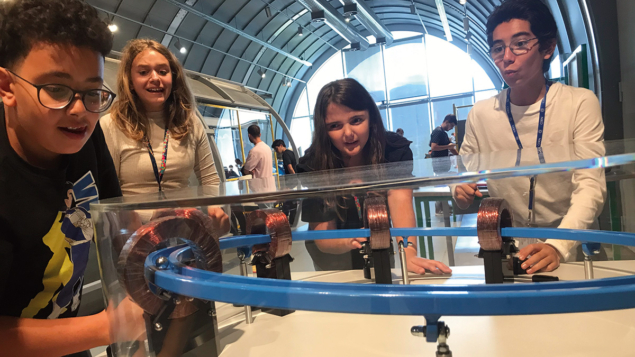To improve the diversity of future generations of scientists, writes Emma Sanders, it is imperative to attract younger audiences today.

The new labs and exhibitions in Science Gateway offer children as young as five and eight, respectively, the opportunity to have fun with science. Why would CERN target such young audiences? And what CERN-related content could possibly be accessible to such an age group?
CERN has traditionally tailored education and outreach material predominantly towards high-school students, in particular those already expressing an interest in science. For this age group, it is relatively easy to find overlaps between school curricula and work at CERN. Such visitors will continue to find engaging content in our exhibitions. However, if CERN is to connect to a broader section of the public and attract a more diverse cohort of future scientists, it needs to reach out beyond existing science fans, attracting younger audiences before stereotypes set in.
Positive contacts
Over the decades, communication best-practice has evolved from the idea that to inspire children to choose a career in science, you just need to make it sound interesting. Now, it is recognised that there are multiple factors influencing choice. The Aspires research project at University College London, for example, has highlighted the importance of “science capital”, a notion based on the variety of positive contacts with science that children experience. This includes knowing people who work in science, talking with family and friends, doing science-based activities outside school and there being a generally positive attitude towards science within the family setting.
At schools, careers information often comes once choices to drop science subjects have already been made. And without role models to identify with, or contact with science or science-related professions through family and friends, it can be extremely difficult for some students to imagine themselves as future scientists. Hence the drop in pupils expressing such aspirations from the end of primary education onwards that occurs in many countries. By offering younger students the opportunity to experiment and play in a scientific environment, Science Gateway seeks to counter this drop. In addition to the existing science-fan visitors, it aims to reach those with less science capital at home, so that children can discover new opportunities.
There is a slogan in the exhibitions world: “hands on, minds on”. A good exhibit creates memorable experiences that empower visitors to explore and engage, rather than simply transmitting knowledge in a unidirectional way. Science Gateway offers activities – such as designing a detector or collaborating to lower equipment into a cavern – where children are encouraged to think logically, and exhibits that encourage them to make their own deductions, helping them to become more confident that science is for them. Here the exhibition guides play a key role in encouraging interaction and play.
Sometimes in a hands-on science centre, one can have the impression that children are having so much fun racing from exhibit to exhibit that there is no valid experience. This is countered by research which shows that learning comes in a broad variety of forms. Informal learning experiences, such as those at Science Gateway, can have just as much impact as in-school learning.
The exhibitions offer a variety of different environments – playful areas and beautiful spaces, including artworks, that can be enjoyed by simply sitting back and reflecting. The exhibitions team has also collaborated with community groups to develop tactile content and ensure the exhibits are accessible to wheelchair users. Not all exhibits will be accessible for younger children, or for the visually impaired, but throughout there is a spread of different experiences that give something for everyone to enjoy.
The ambition is for CERN to become a popular destination for a fun day out, attracting a broad section of the public, both those who might one day become scientists themselves and those who might never choose that path, but who are curious to explore the new buildings that have popped up in their local area. Successful outcomes can be as simple as visitors having fun in a scientific environment. This is a first step towards being open to scientific ideas and methods – a valid goal in today’s world of misinformation and distrust, where science is sometimes talked of as something you might or might not choose to believe in.







